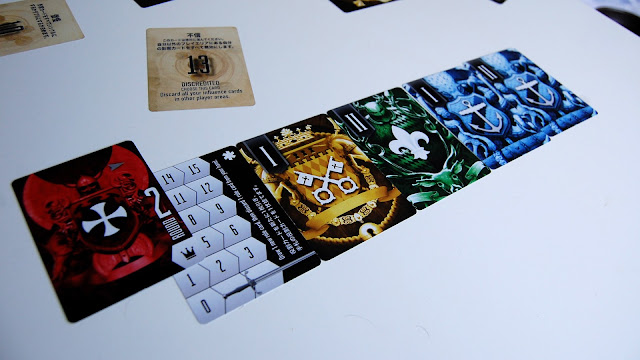
Sometimes things get lost in translation. There's only so much a rulebook can tell you and there are occasions when a rulebook can teach you the mechanics of a game but fail to teach you the spirit of the game. I feel that's where I am with Blood and Fortune. Although I know how to play the game I feel as if I'm missing something, that I have lost some fundamental core of what the game is.
Playing three to six players, Blood & Fortune is a game of bluffing and negotiation, apparently. The aim is to have the best set of scoring cards in front of you and as many of your cards in front of other players as you can. Each card scores only one or two points and at the end of each round you can only score the right most 2-point card in the row.
If Fortune is the victory points then the Blood is how you gain these cards, each round you will offer two of your cards to another player, they choose one and add it to their row. If you've been paying attention you'll realise that you'll need to offer up your 2-point cards at the right time, to ensure your opponent wants to add that card to their row and that it appears as far to the end of that row as possible.
This, in theory, is where the negotiation element of the game comes in. Players should be bartering with each other in order to try and get their high scoring cards on another player’s row as well as maximising the cards they have received. I say in theory because for me this has rarely happened. Instead players are just very shrewd in who they offer cards to, often concentrating on what they see before them rather than negotiation.
And this is where I think something has been lost in translation, rather than a game of boisterous trading we ended up with a quiet game where a single raised eyebrow says more than any trading offer could. This means that Blood & Fortune plays more like a game of poker in some groups.
I haven't mentioned the role cards yet. At the beginning of each round a set of role cards are drafted and these can be offered in trades along with the scoring cards. There's fourteen in total and examples include adding an extra round of trading, reversing the order of a player's row of cards or forcing the owner to remove their cards from the table.
These cards tread a thin line between ammunition for your careful strategy and complete randomness, either adding depth to the game or the equivalent of a hand grenade thrown into the middle of the table. The latter of which can completely spoil a round of careful posturing and negotiation.
The clever thing about these rule cards is that they can be offered along with scoring cards, and some have to be traded away. This is where the role cards come into their own, as they add an extra layer to the negotiations and trading.
There are another set of special powers available on the score cards, giving each player a unique ability for the game. To me these are a layer too far; if we're sticking to an onion metaphor these abilities are the papery outer layer that needs discarding.
So let's get to the brass tacks of this game. I have had some fun with Blood and Fortune but I've had just as many games that have been excruciatingly slow and painful. It's a cop-out to say that this game is situationally dependant but my enjoyment of Blood & Fortune has changed drastically between different groups of players and I think it's because Blood and Fortune is a simpler game than it thinks it is.
But the dilemma I'm having here is this; did the game need the right group to work? Or did the right group make the game work? And I'm being drawn to consider the latter is true, the group that had the most fun with game is the podcast crew, which get vocal and boisterous in almost every game we play.
Blood and Fortune worked better with those groups who enjoyed lighter more boisterous games. Players who enjoyed deeper games went looking for a strategy that Blood and Fortune simply didn't possess and so the game turned into a slow, boring and painful experience. But for those who enjoyed a bit of light backstabbing and are willing to yell at you across the table for giving you a card they didn't want there's something there. My final issue though is that the game didn't make this happen, the players did, which is where I think the game gets lost in translation.
This review is based on a full retail copy of the game provided by the publisher.



Comments
Post a Comment